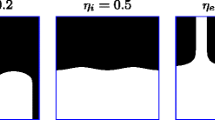Abstract
In this paper we present a method for solving a special three-dimensional design centering problem arising in diamond manufacturing: Find inside a given (not necessarily convex) polyhedral rough stone the largest diamond of prescribed shape and orientation. This problem can be formulated as the one of finding a global maximum of a difference of two convex functions over ℝ3 and can be solved efficiently by using a global optimization algorithm provided that the objective function of the maximization problem can be easily evaluated. Here we prove that with the information available on the rough stone and on the reference diamond, evaluating the objective function at a pointx amounts to computing the distance, with respect to a Minkowski gauge, fromx to a finite number of planes. We propose a method for finding these planes and we report some numerical results.
Similar content being viewed by others
References
E. Bruton,Diamonds (N.A.G. Press, London, 1978).
A. Groch, L. Vigidal and S. Director, “A new global optimization method for electronic circuit design,”IEEE Transactions on Circuits and Systems 32 (1985) 160–170.
R. Hillestad and S. Jacobsen, “Linear programs with an additional reverse convex constraint,”Journal of Applied Mathematics and Optimization 6 (1980) 257–268.
J.-B. Hiriart-Urruty, “Generalized differentiability, duality and optimization for problems dealing with differences of convex functions,” in:Lecture Notes in Economics and Mathematics Systems No. 256 (Springer, Berlin, 1985) pp. 37–70.
T. Pham Dinh, J. Chaarani and S. El Bernoussi, “Global numerical algorithms for solving a class of nonconvex optimization problems,” Laboratoire TIM 3 Technical Report, IMAG, Université de Grenoble (Grenoble, 1988).
R.T. Rockafellar,Convex Analysis (Princeton University Press, NJ, 1970).
R. Rubinstein and G. Samorodnitsky, “Optimal coverage of convex regions,”Journal of Optimization Theory and Applications 51 (1986) 321–343.
J.-J. Strodiot and V.H. Nguyen, “Taille optimale de diamants,” Report 79/5, Department of Mathematics, Facultés Universitaires Notre-Dame de la Paix (Namur, 1979).
J.-J. Strodiot, V.H. Nguyen and N.V. Thoai, “On an optimum shape design problem,” Report 85/5, Department of Mathematics, Facultés Universitaires Notre-Dame de la Paix (Namur, 1985).
P.T. Thach, “The design centering problem as a d.c. programming problem,”Mathematical Programming 41 (1988) 229–248.
N.V. Thoai, “A modified version of Tuy's method for solving d.c. programming problems,” CORE Discussion Paper No. 8528 (Louvain, 1985).
H. Tuy, “A general deterministic approach to global optimization via d.c. programming,” in: J.-B. Hiriart-Urruty, ed.,Fermat Days 85: Mathematics for Optimization (North-Holland, Amsterdam, 1986) pp. 273–303.
L. Vigidal and S. Director, “A design centering algorithm for nonconvex regions of acceptability,”IEEE Transactions on Computer-Aided Design of Integrated Circuits and Systems (1982) 13–24.
Author information
Authors and Affiliations
Rights and permissions
About this article
Cite this article
Nguyen, V.H., Strodiot, JJ. Computing a global optimal solution to a design centering problem. Mathematical Programming 53, 111–123 (1992). https://doi.org/10.1007/BF01585697
Received:
Revised:
Issue Date:
DOI: https://doi.org/10.1007/BF01585697




